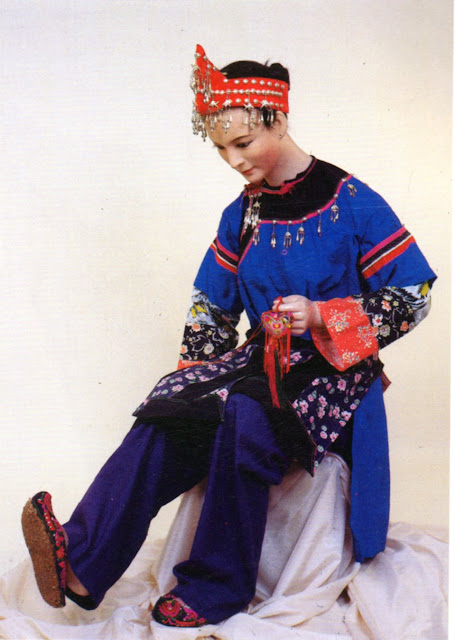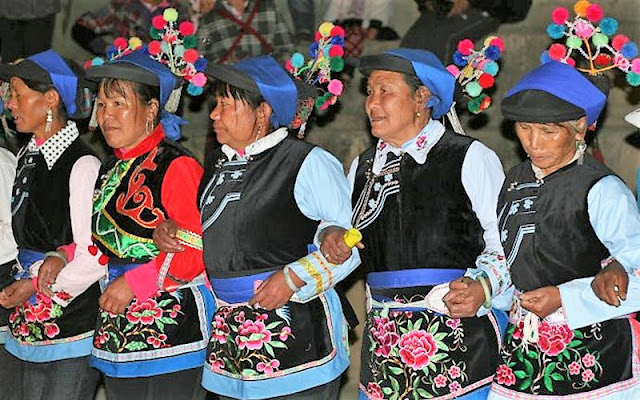
Hello all,
Today I will talk about the Western Yi. Also known as the Lalo. They live in the western part of Yunnan, from Lincang County up to Weishan. Here is a rough map of the area they inhabit.
Jingdong style
This costume is worn in the southern part of this area, from Jingdong County up to Nanjian.
The men's traditional costume includes a vest made from two goatskins, often worn with no shirt. Women sometimes wear this as well.
Jinggu County and Pu'er City
This is the everyday costume followed by the formal costume of this area
Jingdong County
Nanjian County

This costume is from the Wuliang Mountain region of Nanjian County. Here are a couple more images showing this style.

This image shows the costume from the village of Gonglang in Nanjian County.
In this region, and also in the areas further north, there is a tradition called Tiaocai. This is a form of dance which is used to present dishes during a festive banquet. There has recently been a resurgence of this tradition.

The men in particular have invented stage costumes to accompany this practice.
https://www.youtube.com/watch?v=Cn2UgauIRJU
The costume from this region is characterized by the 'guobei', a pad which is worn on the back. Similar mantles of various sizes are worn in many costumes of this area, by Tibetans, Naxi, Bai, and other branches of Yi. The guobei in this area are circular or oval, and come in two types, plain felt with a couple of embroidered motifs, and fully embroidered.
This first type is the more famous. The two rectangular motifs are eyes, which serve to scare demons. The other two motifs are spiders. It happened once that some Yi girls were being pursued by enemy soldiers, and took refuge in a cave. Some spiders saw what was going on, and quickly spun webs over the opening. The soldiers saw the cave, but also saw that the opening was covered with cobwebs, which indicated that the girls could not possibly have entered. The Yi girls in this area embroidered the spiders on the pad to commemorate this saving action.
Other girls put more embroidery on the guobei.
This girls above are from Midu County. The costume is similar to that of Weishan county but shorter.
The costume of Dongshan district of Weishan County is very colorful.
Here is an exceptionally ornate married woman's costume from this region. The guibei seems to be reversable
The costume from Ma-an-shan of Weishan is a little different.

As you can see from the woman above, baby carriers in this area somewhat resemble the guobei, being rounded and smaller than they are in other areas.
Here are a few more images from this area. Some of these resemble the above costumes, others do not, but there are so many different costumes that I do not have good information for them all.
In this image, the girl on the left seems to be wearing a Miao or Dong style headdress. This is not part of any Yi costume, and in fact, belongs to eastern Guizhou Province.
Thank you for reading, I hope that you have found this to be interesting and informative.
Roman Kozak
email: rkozakand@aol.com
Source Material:
Dr Florian Knothe et al, 'Embroidered Identities Ornately Decorated Textiles and Accessories of Chinese Ethnic Minorities' 2014, Hong Kong
Jim Goodman, 'The Exploration of Yunnan', Kunming, 2006
Unknown Author, 'The Costumes and Adornments of Chinese Yi Nationality Picture Album', Beijing, 1990Deng Qiyao et al, 'The Folk Arts of Yunnan Ethnics', Yunnan, 1993
Chen Hongguang et al, 'Ethnic Costumes Clothing Decorations from China', Chengdu, Sichuan, 1995
Bernard Formoso, 'Costumes du Yunnan', Nanterre, 2013
Shan Ren et al, 'The Cream of Yunling - A Photo Odyssey of Yunnan Ethnic Groups', Kunming, 1998


























































